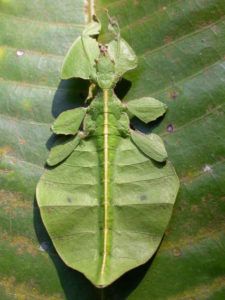[Image: An animal that looks like a plant. From simple.wikipedia.org/wiki/Stick_insect#/media/File:LeafInsect.jpg.]
Future genetic engineering may create animals that can photosynthesize like plants. These animals would require less food because they will make some of it from sunlight. In principle, even humans could be modified this way!
There are already some natural cases of animal-plant integration. Some marine flatworms have algae living in their translucent bodies,between their cells. Increasing the degree of plant-animal integration further, the method used by coral and various other marine animals is to have symbiotic algae living, not between their cells (like the flatworms), but actually inside some of their cells. The algae are typically of the genus Symbiodinium, and live in “symbiosomes,” blobs inside the animal cells that hold the algae separate from the rest of the cell. Each symbiosome is a kind of really, really tiny terrarium (a “nanoterrarium”) maintained by the finely engineered nanotechnology device of nature we call the cell. The cells supply the algae, in its symbiosome home, with basic chemicals and exposure to light. In return the algae produce nutrients that the animals extract from the symbiosome and use. In coral, when these algae die the coral loses color and, if not reversed, itself dies in the phenomenon called “coral bleaching.”
Taking the algae-animal combination another step, there are species of sea sponges, a primitive type of animal, that host algae in leaf-like structures that they grow to better capture underwater sunlight. That’s right: animals with leaves.
The degree of integration can be tighter still. Observe that algae (like their descendants, the plants) do photosynthesis using chloroplasts. These are small green organelles, organelles being the tiny nanomachines that serve as “organs” of cells. Chloroplasts thus give plants their green color. The chloroplasts are thought to have once been independent organisms that, eons ago, took up residence inside cells of other organisms, where they have lived ever since. What about animals whose cells can contain chloroplasts directly, eliminating the inefficiency of using algae as the middleman? There is no reason why this could be created by genetic engineering. Nor is there any reason why something like this could not exist on some other planet already.
[This passage is slightly modified from my book The Human Race to the Future, published by the Lifeboat Foundation.]
